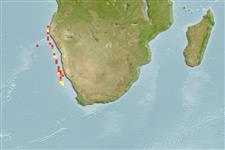Teleostei (teleosts) >
Scombriformes (Mackerels) >
Gempylidae (Snake mackerels)
Etymology: Paradiplospinus: Greek, para = the side of + Greek, diploos = double + Latin, spina, pinna = thron (Ref. 45335).
Environment: milieu / climate zone / depth range / distribution range
Ecology
Marine; bathydemersal; depth range 368 - 626 m (Ref. 6181). Deep-water; 16°S - 30°S, 3°E - 15°E (Ref. 6181)
Southeast Atlantic: known only from off Namibia and western South Africa.
Size / Weight / Age
Maturity: Lm ? range ? - ? cm
Max length : 52.0 cm SL male/unsexed; (Ref. 27121)
Occurs in the upper continental slope (Ref. 6181). Juveniles probably pelagic (probably mesopelagic) (Ref. 6181). Specimens 35 to 40 cm SL had ripe gonads (Ref. 6181).
Life cycle and mating behavior
Maturity | Reproduction | Spawning | Eggs | Fecundity | Larvae
Nakamura, I. and N.V. Parin, 1993. FAO Species Catalogue. Vol. 15. Snake mackerels and cutlassfishes of the world (families Gempylidae and Trichiuridae). An annotated and illustrated catalogue of the snake mackerels, snoeks, escolars, gemfishes, sackfishes, domine, oilfish, cutlassfishes,. scabbardfishes, hairtails, and frostfishes known to date. FAO Fish. Synop. 125(15):136 p. (Ref. 6181)
IUCN Red List Status (Ref. 130435: Version 2024-2)
Threat to humans
Harmless
Human uses
Tools
Can't connect to MySQL database fbquizv2. Errorcode: Too many connections
